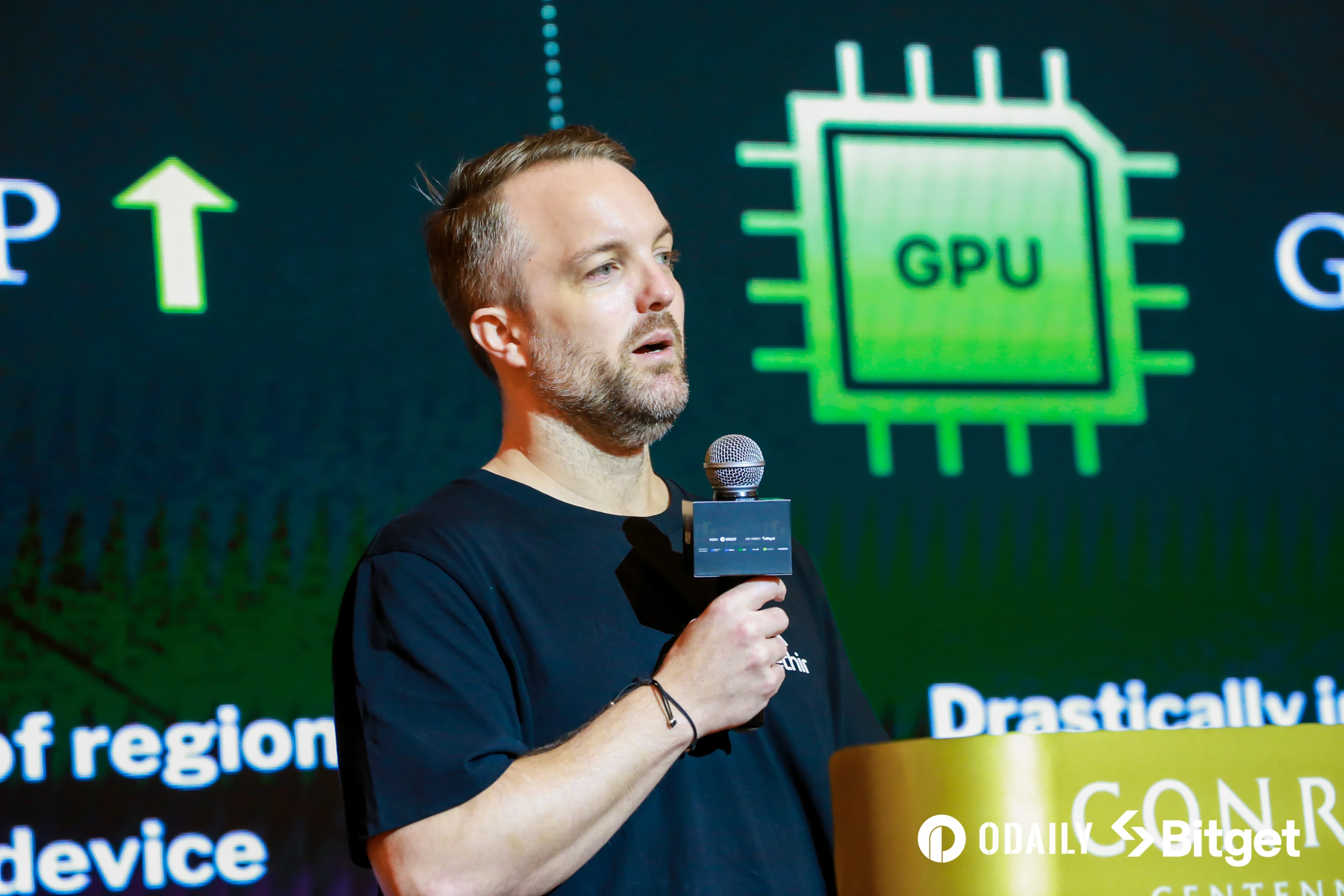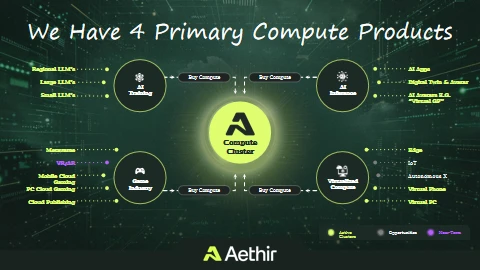Mark, cofundador de Aethir: Construyendo una infraestructura descentralizada para la IA y los juegos del futuro | Premios FAT 2024
On September 16, the annual ceremony of FAT Awards 2024 was grandly opened at the Conrad Hotel in Singapore. FAT is a ranking ceremony + summit forum brand founded by Odaily Planet Daily in 2020, aiming to reward the leaders and innovators of Web3 and the crypto industry, and focus on value paradigms and consensus moments. In 2024, when the crypto industry is changing with each passing day and narratives are recognized by the mainstream world, fresh narratives are surging, the ecology is flourishing, and high-quality projects are launched one after another. Odaily Planet Daily once again opened the FAT list selection and held an offline ceremony.
At the event, Aethir co-founder Mark gave a speech on the topic of Aethir: Future Artificial Intelligence and Gaming Infrastructure.
Mark said that GPU resource shortage is a core global problem, and Aethir will be committed to solving this problem by building a decentralized cloud infrastructure. Aethir will effectively integrate and redistribute decentralized GPU resources to markets with demand. This innovative model not only improves resource utilization efficiency, but also provides enterprises with a flexible, efficient and cost-effective solution.
Aethirs products and services are designed to meet the high-performance computing needs of enterprise customers in the fields of AI and gaming. By providing customized computing power purchase options, customers can choose the number of GPUs, region, and usage time according to their specific needs, thereby achieving the optimal configuration of resources.
In addition, Aethir also focuses on transferring the computing needs of games from local devices to the cloud through technological innovation, and through streaming technology, even low-configuration users can enjoy high-quality gaming experience. This model not only expands the potential user base of game companies, but also provides a new solution for the 2.8 billion users around the world who cannot access large games.
The following is the full text of Marks live speech, edited by Odaily Planet Daily, enjoy~
Thank you very much for inviting me to this event and thank you Odaily for hosting this great event. Let me introduce myself briefly. I am Mark, the co-founder of Aethir. We founded this company in Beijing. I love the crypto community in China very much and I am very happy to share the work we do at Aethir.
I’m sure you’ve seen this in media reports before, that there is a huge GPU shortage worldwide. Musk once mentioned that GPUs are harder to buy than drugs; Zuckerberg has invested a lot of resources in GPUs; Musk has also launched huge data centers, which are absolutely necessary for AI. Without GPUs, you can’t build AI systems. However, the problem is not just simple resource scarcity. Let’s break this problem down into four key parts.
-
The first is supply pressure. There is a huge demand for GPUs in the market. The demand for GPUs from large companies is huge, which puts huge pressure on the supply side, which in turn leads to the second problem – production constraints.
-
NVIDIA can only produce a certain number of chips each year, and their manufacturing is limited by the supply of raw materials, which are usually allocated to large technology companies, making it difficult for startups to access these resources.
-
The third issue is the complexity of large language models (LLMs). Examples include ChatGPT 3, 4, and the recently released GPT-4o. As these models get better, their training costs are growing exponentially. ChatGPT 4 is much more expensive to train than ChatGPT 3, and this cost increase is due to the need for more compute resources and data. However, despite the exponential increase in demand, the performance of the models is not exponential, but linear. So, the current processing power and demand are getting higher, but the performance improvement is not proportional.
-
The final point, and the one most relevant to Aethir, is the issue of efficiency. GPU utilization in data centers around the world is very low, with only about 15% of the chips being used.
So what did we build? We built a decentralized cloud infrastructure, and a base layer that enables decentralized GPUs to be connected and redistributed to the demand side of the market, leveraging that “lost supply”.
Companies like AWS, Google, Azure have the ability to collect your assets and redistribute them to external users. Just like how Airbnb operates, but you cant bring these resources to market without the infrastructure to support them, and this is exactly what we do with GPUs. We aggregate from data centers, enterprises, anywhere there are high-performance GPUs to meet our customers needs.
What does our product look like? Its very simple to operate, and users can purchase computing power based on their needs, choose a specific number of GPUs, a specific region, and a specific duration. Decentralization does not mean there is no centralized hosting. In fact, large-scale training requires centralized hosting of GPUs because there are huge advantages. This is why billions of dollars are invested in these data centers. There are many high-quality clusters throughout the network that can support large-scale training in the deployment structure.
So how is Aethir different? From a deeper perspective, the purpose of a decentralized physical infrastructure network is to build a network target and be managed by a centralized organization. We serve our customers by aggregating GPU networks, and we only aggregate enterprise-grade GPUs, so our GPUs are all enterprise-grade infrastructure. This means that our network can meet the needs of any enterprise customer in the Web3 field.
The traditional challenge is that aggregating consumer hardware may be a better option, usually this hardware comes from ordinary users who become part of the network and contribute to it. It is common to build networks around consumer hardware, but there is a challenge that this hardware is difficult to sell because it comes from personal computers (PCs) in the community, and how to make customers believe that these computers will not be turned off at any time and how to build trust is a difficult problem. Building an enterprise-level network based on consumer devices is very difficult, and our solution has a higher ceiling from a revenue perspective.
Below are our computing products. First is the H100 GPU, which is one of the top GPUs currently. In the upper right corner is AI inference, which is the technical term for AI to perform tasks. For example, the operation process of ChatGPT is called inference. AI applications mainly rely on this part. Below is the gaming industry, including PC cloud gaming, cloud publishing, and virtual computing. We also support innovative cloud mobile virtualization services, such as serving Chinese mobile phone users.
Many people know Aethir for our work in AI, but I want to talk about our work in gaming. The vast majority of gamers around the world use low-end devices, and many of the worlds most popular games are unplayable to these users because their devices are not powerful enough to run these computationally intensive games. This means that 2.8 billion users around the world are out of reach for large game companies, which is a difficult problem to solve.
So how do we solve this problem? There are three scenarios:
-
Giving users more money would allow them to afford high-performance devices, but this is unlikely.
-
Improving technology and democratizing hardware is also unrealistic.
-
Using existing technology, we can offload the computing needs of games from local devices to the cloud and stream them to the cloud, allowing users to play games without high-performance hardware. But the challenge is how to effectively scale this solution. This is where DePIN comes in, it is far superior to expensive centralized computing solutions in terms of scalability and economic benefits. Aethir has been building this system from the beginning, and we have expanded it in Asia. I think this will make gaming accessible to everyone.
Here are some recent highlights: We currently have 190 employees, 100 of whom are engineers working on centralized hosting. A few weeks ago, we were listed on the Korean exchange.
Next up is the Aethir Edge, our physical mining device, built in partnership with some of the world’s top semiconductor companies like Qualcomm, that connects to your WiFi and runs passively as an edge computing node, allowing us to handle your enterprise tasks and even run some mobile games. As small language models become more common, these devices will become more commonplace. Not only does it run Aethir’s token mining, it also provides computing resources for other projects, giving more projects access to Aethir’s computing power. We’ve sold 25,000 of them so far, and we’re expanding distribution, with permission to enter the US market. You can learn more at myedge.io. We’ve also rented Mandala, which we’ll be able to visit and experience over the next three days.
You can join as an Aethir computing power provider through the official application link .
This article is sourced from the internet: Aethir Co-Founder Mark: Building decentralized infrastructure for future AI and games | FAT Awards 2024
Relacionado: Investigación de GoPlus: profundizando en Eigenlayer, diseño y construcción de AVS
Autor original: GoPlus background Desde el año pasado hasta hoy, EigenLayer, como narrativa central en el ecosistema Ethereum, ha acumulado más de $10 mil millones en TVL. Sin embargo, la mayoría de la gente puede considerarlo simplemente como una infraestructura financiera, principalmente porque la característica más conocida de EigenLayer es su concepto de Restaking. Esta impresión inicial hace que sea fácil para la gente pensar que EigenLayer es solo una plataforma que ayuda a los usuarios a obtener ingresos adicionales por staking. De hecho, cuando pensamos profundamente, surge una pregunta clave: ¿Por qué el ETH re-staking o LST (tokens de staking de liquidez) pueden generar ingresos adicionales? La respuesta a esta pregunta revela la verdadera naturaleza de EigenLayer. Creo que EigenLayer es en realidad una infraestructura revolucionaria de computación en la nube impulsada por las finanzas. Esta definición puede sonar contradictoria al principio, pero refleja precisamente la innovación de…












